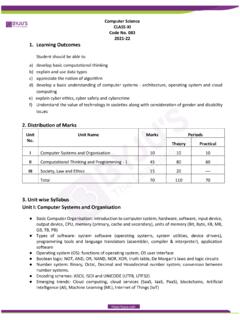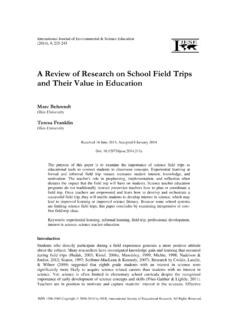Transcription of CBSE Class 10 Science Chapter 8 How Do Organisms …
1 CBSE Class 10 Science Chapter 8 How Do Organisms Reproduce Notes Over the years, we have two primary ways for Organisms to reproduce - sexual and asexual reproduction. Almost all of the higher Organisms use the sexual mode of reproduction to ensure lineage and continuity of species. Explore in detail about reproduction through Chapter 8 How do Organisms reproduce? Topics Covered in Chapter 8 How Do Organisms Reproduce: Do Organisms Create Exact Copies Of Themselves? The Importance Of Variation Modes Of Reproduction Used By Single Organisms Fission Fragmentation Regeneration Budding Vegetative Propagation Spore Formation Sexual Reproduction Why The Sexual Mode Of Reproduction? Sexual Reproduction In Flowering Plants Reproduction In Human Beings Introduction To The Chapter Reproduction is a very important biological process for all Organisms in the continuity of the generations. There are different types of living species existing on this planet earth.
2 Few are a single-celled organism, some are multicellular organism while few species lack a true nucleus and other cell organelles. Reproduction varies with the species. What is Reproduction? Reproduction is the biological process in which every living Organisms give rise to their young ones which are identical to their parents. The nucleus of the cell contains DNA which is the CBSE Class 10 Science Chapter 8 How Do Organisms Reproduce Notes hereditary material. DNA replicates and forms new cells causing variations. So, these cells new cells will be similar but may not be identical to the original cell. The variations are useful for the survival of the individual and species over time as well as basis for evolution. Types of Reproduction There are two main types of Reproduction. Asexual Reproduction It is a type of reproduction by which offspring are produced from a single parent. Here gametes are not formed and the new individual is identical to the parent.
3 It is extremely useful as a means of rapid multiplication and is usually observed in lower Organisms . Asexual reproduction can be of various types: Binary fission, Budding, Vegetative reproduction, Regeneration, Fragmentation, Spore formation, and Parthenogenesis. Sexual Reproduction It is the process of reproducing their young ones by the involvement of both the parents. Here, gametes are formed and the new individual is genetically similar but not identical to the parents. It is useful to generate more variations in species and is usually observed in higher Organisms . All multicellular Organisms , including few plant species, animals and humans undergo Sexual Reproduction. Importance Of Variation Variation is useful for the survival of species over time If a population of reproducing Organisms were suited for a particular niche and if the niche were drastically altered, the population could be wiped out But if some variations were to be present in a few individuals in these populations, there would be some chance for them to survive Modes of Asexual Reproduction Fission The parent cell divides into daughter cells -> Binary fission - 2 cells are formed.
4 Example- Amoeba CBSE Class 10 Science Chapter 8 How Do Organisms Reproduce Notes -> Multiple fission - many cells are formed. Example - Plasmodium Fragmentation The organism breaks-up into smaller pieces upon maturation, each piece develops into a new individual. Example - Spirogyra CBSE Class 10 Science Chapter 8 How Do Organisms Reproduce Notes Regeneration If an organism is somehow cut or broken into many pieces, each piece grows into a complete organism. Example - Hydra, Planaria Budding A bud is formed which develops into tiny individual. It detaches from parent body upon maturation and develops into a new individual. Example - Hydra CBSE Class 10 Science Chapter 8 How Do Organisms Reproduce Notes Vegetative Propagation In many plants, new plants develop from vegetative parts such as By roots - Example - Dahlias, Sweet potato By stem - Example - Potato, Ginger By leaves - Example - Bryophyllum (leaf notches bear buds which develop into plants) Artificial Methods In Vegetative Propagation Grafting - Example - Mango Cutting - Example - Rose Layering - Example - Jasmine Tissue culture - Example - New plants are grown using growing tips of a plant CBSE Class 10 Science Chapter 8 How Do Organisms Reproduce Notes These growing cells are kept in a culture medium leads to the formation of callus.
5 Callus is then transferred to the hormone medium which causes growth and differentiation. Example - Ornamental plants, orchid Benefits of Tissue Culture We can grow plants like Banana, Rose, Jasmine etc that have lost the capacity to produce seeds New plants are genetically similar to parents Helps in growing seedless fruits Spore Formation Spores are small bulb like structures which are covered by thick walls. Under favourable conditions, they germinate and produce new organism. Example - Rhizopus Sexual Reproduction When reproduction takes place as a result of the fusion of male and female gametes is called sexual reproduction. The fusion of gametes is called fertilization which results in variation. Sexual Reproduction In Plants Flowers are the reproductive organs of plants A typical flower consists of four main whorls namely sepals, petals, stamen and pistil Types Of Flowers Bisexual Flower - Both male and female reproductive parts are present.
6 Example - Hibiscus, mustard Unisexual Flower - Either male or female reproductive part is present. Example - Watermelon, Papaya CBSE Class 10 Science Chapter 8 How Do Organisms Reproduce Notes Structure Of Flower Process of Seed Formation Pollen grains, produced in the anther, are transferred to the stigma of the same flower (self-pollination) or stigma of another flower (cross-pollination) through agents like air, water or animals Pollen grains germinate and form pollen tubes which pass through the style to reach up to the ovules present in the ovary The fusion of male and female gametes is called fertilization. The zygote is produced inside the ovary. The zygote divides to form the embryo. Ovule develops a thick coat and changes into seed gradually Ovary changes into fruit and other parts of flower fall off Germination of pollen on stigma The seed germinates to form a plant under suitable conditions such as air, moisture etc CBSE Class 10 Science Chapter 8 How Do Organisms Reproduce Notes Reproduction in Human Beings Humans use the sexual mode of reproduction.
7 Sexual maturation - the period of life when production of germ cells , ova (female) and sperm (male) start in the body. This period of sexual maturation is called puberty. Changes at Puberty Common in male and female - Thick hair growth in armpits - Skin becomes oily, may result in pimples In Girls - Breast size begins to increase - Girls begin to menstruate In Boys - Thick hair growth on the face - Voice begins to crack These changes signal that sexual maturity is taking place Male Reproductive System (i) Testes A pair of testes are located inside scrotum which is present outside the abdominal cavity Scrotum has a relatively lower temperature needed for the production of sperms Male germ cells , sperms are formed here Testes release male sex hormone (testosterone) CBSE Class 10 Science Chapter 8 How Do Organisms Reproduce Notes Function of Testes Regulates production of sperms Brings changes at puberty (ii) Vas Deferens It passes sperm from the testes to the urethra (iii) Urethra It is a common passage for both sperm and urine.
8 Its outer covering is called penis. (iv) Associated glands Seminal vesicles and prostate gland add their secretion to the sperms. This fluid provides nourishment to sperms and makes their transport easy Sperm along with the secretion of glands form semen Female Reproductive System (i) Ovary A pair of ovaries are located on both sides of the abdomen Female germ cells , eggs are produced here At the time of the birth of a girl, thousands of immature eggs are present in the ovary At the onset of puberty, some of these eggs start maturing One egg is produced every month by one of the ovaries (ii) Oviduct or Fallopian Tube Receives the egg produced by the ovary and transfers it to the uterus Fertilization , a fusion of male and female gametes takes place here CBSE Class 10 Science Chapter 8 How Do Organisms Reproduce Notes (iii) Uterus It is a bag-like structure where development of the baby takes place Uterus opens into the vagina through cervix Fertilization of Egg When egg is fertilized - The fertilized egg called zygote is planted in the uterus and develops into an embryo - The embryo gets nutrition from the mother's blood with the help of a special tissue called placenta.
9 It provides a large surface area for the exchange of glucose, oxygen and waste material - the time period from fertilization upto the birth of the baby is called gestation period. It is about 9 months. When egg is not fertilized - The uterus prepares itself every month to receive fertilized egg - The lining of the uterus becomes thick and spongy, required to support the embryo - When fertilization has not taken place, this lining is not needed any longer - This lining breaks and comes out through vagina as blood and mucus - This cycle takes around 28 days every month and called menstruation Reproductive Health CBSE Class 10 Science Chapter 8 How Do Organisms Reproduce Notes Reproductive health means a total well-being in all aspects of reproduction , physical, social, emotional and behavioral. -> Sexually Transmitted Diseases (STDs) Many diseases can be sexually transmitted such as - Bacterial: Gonorrhoea and Syphilis - Viral.
10 Warts and HIV-AIDS Use of condoms prevents these infections to some extent Contraception - It is the avoidance of pregnancy, can be achieved by preventing the fertilization of ova -> Methods of Contraception (i) Physical barrier To prevent union of egg and sperm Use of condoms, cervical caps and diaphragm (ii) Chemical methods Use of oral pills These changes hormonal balance of body so that eggs are not released May have side effects (iii) Intrauterine contraceptive device (IUCD) Copper-T or loop is placed in uterus to prevent pregnancy (iv) Surgical methods In males, the Vas deferens is blocked to prevent sperm transfer called vasectomy In females, the fallopian tube is blocked to prevent egg transfer called tubectomy Female Foeticide The practice of killing a female child inside the womb is called female foeticide For a healthy society, a balanced sex ratio is needed that can be achieved by educating people to avoid malpractices like female foeticide and prenatal sex determination Prenatal sex determination is a legal offence in our country so as to maintain a balanced sex ratio CBSE Class 10 Science Chapter 8 How Do Organisms Reproduce Notes Few Important Questions What is Gametogenesis What is Sexual and Asexual Reproduction?













